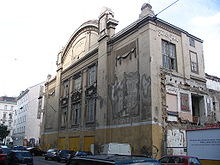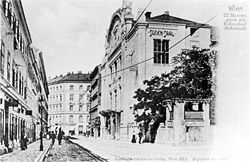
Sofiensaal
Encyclopedia

Vienna
Vienna is the capital and largest city of the Republic of Austria and one of the nine states of Austria. Vienna is Austria's primary city, with a population of about 1.723 million , and is by far the largest city in Austria, as well as its cultural, economic, and political centre...
, Austria
Austria
Austria , officially the Republic of Austria , is a landlocked country of roughly 8.4 million people in Central Europe. It is bordered by the Czech Republic and Germany to the north, Slovakia and Hungary to the east, Slovenia and Italy to the south, and Switzerland and Liechtenstein to the...
. It was situated on Marxergasse, in the city's third district of Landstraße
Landstraße
Landstraße is the 3rd municipal District of Vienna, Austria] . It is near the center of Vienna and was established in the 19th century. Landstraße is a heavily populated urban area with many workers and residential homes. It has inhabitants in an area of 7.42 km². It has existed since...
. It burned down on 16 August 2001, although the facade of the building is still intact.
Creation and initial use
The building was completed in 1826, designed by the architects August Sicard and Eduard van der NüllEduard van der Nüll
Eduard van der Nüll was an Austrian architect, who was one of the great masters in the historicist style of Vienna's Ringstrasse.-Life and work:...
. It was named after Princess Sophie of Bavaria
Princess Sophie of Bavaria
Sophie Friederike Dorothee Wilhelmine, Princess of Bavaria was born to King Maximilian I Joseph of Bavaria and his second wife Karoline of Baden. She was the identical twin sister of Princess Maria Anna of Bavaria, Queen of Saxony as wife of Frederick Augustus II of Saxony...
, the mother of Emperor Franz Josef I. It was originally used as a steam bath and known as the Sofienbad. Between 1845 and 1849, it was converted into a dance hall and renamed the Sofiensaal. Johann Strauss I
Johann Strauss I
Johann Strauss I , born in Vienna, was an Austrian Romantic composer famous for his waltzes, and for popularizing them alongside Joseph Lanner, thereby setting the foundations for his sons to carry on his musical dynasty...
performed there regularly and conducted at the opening ball of the house in 1848. Many of the Strauss family's waltzes were first performed there.

Use as a recording venue
The building's large, vaulted ceiling, and the pool beneath the floor, gave the hall excellent acoustic properties. For this reason, Decca RecordsDecca Records
Decca Records began as a British record label established in 1929 by Edward Lewis. Its U.S. label was established in late 1934; however, owing to World War II, the link with the British company was broken for several decades....
adopted the building as its principal European recording venue from 1950, mono recording and 1955, stereo recording (Le nozze di Figaro conducted by Erich Kleiber, die zauberflot conducted by Karl Bohm and others Mozart operas) to the mid-1980s. The senior producer of classical recordings for the company for much of this time was John Culshaw
John Culshaw
John Royds Culshaw OBE was a pioneering English classical record producer for Decca Records. He recorded a wide range of music, but is best known for masterminding the first studio recording of Wagner's Der Ring des Nibelungen, begun in 1958.Largely self-educated musically, Culshaw worked for...
, who revolutionised the recording of classical music, particularly opera with the Decca tree. Notable recordings made at the Sofiensaal during this period included the first complete studio recording of Wagner
Richard Wagner
Wilhelm Richard Wagner was a German composer, conductor, theatre director, philosopher, music theorist, poet, essayist and writer primarily known for his operas...
's Ring Cycle, conducted by Georg Solti
Georg Solti
Sir Georg Solti, KBE, was a Hungarian-British orchestral and operatic conductor. He was a major classical recording artist, holding the record for having received the most Grammy Awards, having personally won 31 as a conductor, including the Grammy Lifetime Achievement Award. In addition to his...
.
Later years and destruction
In later years the Sofiensaal fell into disuse as a recording studio and was used for parties and discos. The last recording made there, in July 2001, was of Arcadi VolodosArcadi Volodos
Arcadi Volodos is a Russian pianist. His first name is sometimes transliterated Arcady or Arkady. Volodos is renowned both for his technical mastery of the instrument's virtuosic repertoire and for his notoriously technically difficult arrangements of...
playing solo piano works by Franz Schubert
Franz Schubert
Franz Peter Schubert was an Austrian composer.Although he died at an early age, Schubert was tremendously prolific. He wrote some 600 Lieder, nine symphonies , liturgical music, operas, some incidental music, and a large body of chamber and solo piano music...
.
In May 2001, the building's owners announced that it would be used as a conference centre. However, it was destroyed by fire on 16 August 2001, due to careless routine maintenance work. The fire burned for more than eight hours and completely destroyed the main ballroom, although the facade and walls of the building survived. Some of the decorative stucco work on the walls survived the fire, as did the adjacent Blauer Salon, a small side venue. There were no reported deaths or injuries.
In January 2006, it was announced that the Sofiensaal is to be redeveloped and converted into apartments.

